 87% off ends soon!
87% off ends soon!  87% off ends soon!
87% off ends soon! Fuel your email subscriber growth while getting your content in front of your audience.
By clicking the button above, you state that you have read and agree to the Service Agreement and Data Processing Terms.
reCAPTCHA subject to the Google Privacy Policy and Terms of Service.
All services provided by AWeber Systems, Inc. (AWeber or Company) may be used for lawful purposes only. Transmission or storage of any information, data or material in violation of any United States Federal, State or City law is prohibited. This includes, but is not limited to: copyrighted material, material legally judged to be threatening or obscene, or material protected by trade secret and other statute. The subscriber agrees to indemnify and hold harmless AWeber from any claims resulting from the use of the service which damages the subscriber or any other parties.
Spamming, or the sending of unsolicited email, using an email address, URL that is maintained on an AWeber machine, or directing traffic to a webpage that contains any reference to AWeber is STRICTLY prohibited. AWeber will be the sole arbiter as to what constitutes a violation of this provision. This action WILL RESULT in immediate termination of your account without refund. Any service interruptions as a result of subscribers spamming will be billed to the subscriber at $50.00 per hour until service is restored. Subscriber will also be in violation of the AWeber Service Agreement and subject to legal action.
Importing or in any way using purchased leads with an AWeber account is strictly prohibited. If you paid money or in any way purchased a group of pre-existing leads, these may not be used with AWeber. This includes co-registration services, "safe lists" or any type of free leads given to you. Only people that have specifically requested information directly from you may be emailed through AWeber.
Batching or in any way trying to script the addition of new subscribers to the web form subscribe methods is strictly forbidden. A script must not be used to auto submit a web form subscriber on behalf of a website visitor. The visitor who desires to subscribe to your list must be the one to activate that subscription process.
No individual under the age of sixteen (16) may use the Services, provide any personal information to AWeber, or otherwise submit personal information through AWeber Services (including, for example, a name, address, telephone number, or email address).
Pornography and sex-related merchandising are prohibited on any AWeber server. AWeber will be the sole arbiter as to what constitutes a violation of this provision.
The collecting of personal data revealing racial or ethnic origin, political opinions, religious or philosophical beliefs, or trade-union membership, and the processing of genetic data, biometric data for the purpose of uniquely identifying a natural person, data concerning health or data concerning a natural person's sex life or sexual orientation is prohibited. AWeber will be the sole arbiter as to what constitutes a violation of this provision.
Subscribers are prohibited from transmitting on or through any of AWeber’s services any material that is, in AWeber’s sole discretion, unlawful, obscene, threatening, abusive, libelous, or hateful, or that encourages conduct which would constitute a criminal offense, give rise to civil liability, or otherwise violate any local, state, national or international law.
Payment is due immediately after the date of invoice. All payments must be in US dollars and withdrawable from a US bank. The subscriber is responsible for providing up-to-date payment information. AWeber will not be held responsible should the subscriber's payment information become out-of-date.
If payment is by credit card, the subscriber authorizes AWeber to charge the credit card listed on the subscription form for those charges for AWeber services that may accrue from month to month, or for any past-due balances, in order to bring the account to current status. Credit card payments will be billed and charged automatically, and AWeber may charge the amount due to the provided card at any time.
Accounts are in default if payment is not received within 20 days after the date of invoice. If a subscriber's check is returned by the bank as unredeemable, the subscriber will be deemed to be in default, and will be liable for a "returned check" charge of $25. Accounts unpaid 20 days after the date of invoice may have their service interrupted. Such interruption does not relieve the subscriber from the obligation to pay the monthly charge. Only a written request to terminate your service relieves you of your obligation to pay the monthly account charge. Accounts in default are subject to a late payment charge of $25 and an interest charge of 1.5% per month on the outstanding balance. If the subscriber's state law does not allow an interest rate of 1.5% per month, the maximum allowable rate for the subscriber's state will be charged. If the subscriber defaults, the subscriber agrees to pay AWeber its reasonable expenses, including attorney and collection agency fees, incurred in enforcing its rights under these Terms and Conditions.
All files, information and mail under the account will be preserved for 20 days from the date the payment is due. If the payment is not received after 20 days, all files, information and mail under the account will be deleted. If the subscriber wishes to use the service again, the subscriber must re-apply as a new subscriber.
The subscriber agrees that the company has the right to delete all data, files or other information that is stored in the subscriber's account if the subscriber's account with the company is terminated, for any reason, by either AWeber or the subscriber. System accounts can not be transferred or used by anyone other than the subscriber. Accounts which have been transferred to other parties, or show other activity in violation of this paragraph, are subject to immediate cancellation.
AWeber shall have the right to suspend service to the subscriber at any time, and for any reason, without notice. If such a suspension is to last for more than 20 days, the subscriber will be notified as to the reason.
Service provided by AWeber may be cancelled in writing at any time with no penalty. Customer Account Login/Email and Response to Security Question must be included in the cancellation request. Cancellation will take effect only when the receipt of the cancellation request is confirmed by AWeber. AWeber reserves the right to change the rate by notifying the subscriber 15 days in advance of the effective date of the change.
AWeber exercises no control whatsoever over the content of the information passing through AWeber systems. All leads (email addresses) generated by subscribers are held strictly confidential. The leads are never released to any other parties for any purpose. The lead information is only used on AWeber servers to deliver the follow up messages designated by the subscriber.
AWeber is committed to respecting intellectual property rights. If you identify copyrighted material that belongs to you posted without your permission to www.aweber.com or sent through the services please follow the directions below to let us know.
Our designated agent is as follows:
Sean Cohen
4275 County Line Rd #20
PMB 186
Chalfont, PA 18914
[email protected]
The subject of your communication should be: DMCA Takedown Request
Your notice must include all of the following:
Ecommerce allows you to process your customers’ payments using payment processor integrations provided by AWeber.
By using Ecommerce:
You are solely responsible for your statements, products, and services listed and sold through Ecommerce including any and all damages, claims, liabilities and costs incurred. You shall be solely responsible for procuring, fulfilling, and delivering your products and services.
You are responsible for understanding and complying with all applicable international, federal, state, and local laws, statutes, rules, regulations and codes including those related to tax and data privacy related to your use of Ecommerce and any ongoing choices you make with Ecommerce related data.
You agree you are solely responsible for determining and collecting, withholding, reporting, and remitting correct taxes to the appropriate tax authority. AWeber expressly disclaims any liability for taxes owed or due by you or your customers for any transaction.
You agree you are responsible for all customer service policies and issues relating to your listed products and services, including pricing, order fulfillment, cancellations, returns and adjustments, warranty, and technical support. AWeber is responsible only for the customer support of your AWeber account.
Stripe
Stripe is not an affiliate, partner, agent, or representative of AWeber. You understand and agree that AWeber is an independent party and has no right, responsibility, or ability to control, direct, or influence any action, inaction, conduct, or decision made by Stripe.
Stripe is solely responsible for all activities, issues and disputes related to Ecommerce payment processing including payment receipt, refunds, chargebacks, and taxes.
You and your customers should contact Stripe directly to resolve any issues with payment processing regarding any of the above indicated activities which Stripe is solely responsible for providing. All payment information provided by your customers using Ecommerce will be passed directly to Stripe.
AWeber will not have access to billing information. AWeber does not manage and is not responsible for the PCI-DSS compliance obligations and efforts of Stripe.
Your previous Email Service Provider (ESP) login information can be shared with AWeber to facilitate migrations. Our migration team will instruct you on how to securely provide your prior ESP login information and any other information required to successfully login (e.g. security questions). AWeber does not share, store, process, or retain your prior login information for any purpose other than to provide migration services.
Customer acknowledges and consents to AWeber accessing your account for which you have provided login information. All attempts will be made to limit viewing of data to only what is necessary to perform your migration. However, Customer acknowledges that AWeber may inadvertently view sensitive personal information within your account such as billing information, but will not collect, store, or otherwise disclose this information. AWeber will make every attempt to not manipulate data, or make alterations when migrating customer data. Only in the event of a technical issue preventing data migration will AWeber take action to change data being imported to AWeber.
Customer agrees to provide clear instructions on what data is to be migrated.
Should the Customer's prior ESP account become compromised in any way, customer will indemnify AWeber for any resulting damages.
It is the responsibility of the Customer to maintain their role and compliance as a Data Controller per local or national privacy regulations (e.g. GDPR, CCPA) for all Data Subjects which possess personal information. AWeber acts as a Data Processor only in the migration process and will only act on the direct instruction and consent of the Customer. Customers are responsible for properly informing Data Subjects about the processing of data, where it is stored, and who is involved per local or national privacy regulations.
Customer agrees to change the password for the prior ESP login upon confirmation from AWeber of a completed migration. Customer agrees to indemnify AWeber if prior ESP login information is not updated.
The AWeber Free Trial (“Free Trial”) begins on the date of enrollment and continues for the duration specified at the time of account creation. During this period, you will have access to AWeber’s services without charge, subject to the Free Trial usage limits outlined below. AWeber reserves the right to modify, suspend, or terminate the Free Trial offer at any time without prior notice.
Your paid subscription will begin automatically at the end of your trial period based on the plan you selected at enrollment and your current subscriber count at the time your trial ends.
The Free Trial is limited to one per customer account and cannot be combined with any other promotional offers. Free Trials are non-transferable and cannot be applied consecutively.
If you exceed the subscriber or email sending limits during your Free Trial, your trial will end immediately and your paid subscription will begin.
AWeber makes no warranties of any kind, whether expressed or implied, for the service it is providing. AWeber also disclaims any warranty of merchantability or fitness for a particular purpose. AWeber will not be responsible for any damage suffered. This includes loss of data resulting from delays, nondeliveries, misdeliveries, or service interruptions caused by AWeber’s negligence or the subscriber's errors or omissions. Use of any information obtained via AWeber is at your own risk. AWeber specifically denies any responsibility for the accuracy or quality of information obtained through its services.
LIMITED LIABILITY. ANY LIABILITY OF THE COMPANY, INCLUDING WITHOUT LIMITATION ANY LIABILITY FOR DAMAGES CAUSED OR ALLEGEDLY CAUSED BY ANY FAILURE OF PERFORMANCE, ERROR, OMISSION, INTERRUPTION, DELETION, DEFECT, DELAY IN OPERATION OR TRANSMISSION, COMMUNICATIONS LINE FAILURE, THEFT OR DESTRUCTION OF OR UNAUTHORIZED ACCESS TO, ALTERATION OF, OR USE OF RECORDS, WHETHER FOR BREACH OF CONTRACT, TORTUOUS BEHAVIOR, NEGLIGENCE, OR UNDER ANY OTHER CAUSE OF ACTION, SHALL BE STRICTLY LIMITED TO THE AMOUNT PAID BY OR ON BEHALF OF THE SUBSCRIBER TO THE COMPANY FOR THE CURRENT MONTH.
Should any provision of this agreement be held to be illegal, invalid, or unenforceable by a court of law, the legality, validity and enforceability of the remaining provisions of this agreement shall remain unaffected thereby unless otherwise stated.
This agreement shall be governed by the laws of the State of Pennsylvania and the United States.
These Terms and Conditions supersede all previous representations, understandings or agreements and shall prevail notwithstanding any variance with terms and conditions of any order submitted. Use of AWeber services constitutes acceptance of these Terms and Conditions.

Blog automations trigger emails sent to your audience the moment you publish a new blog.
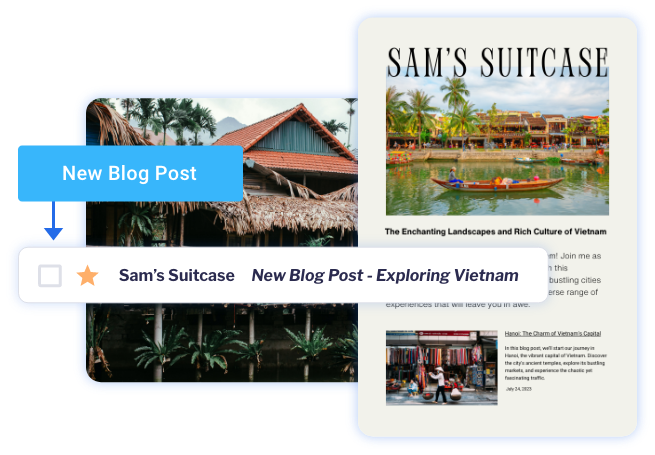
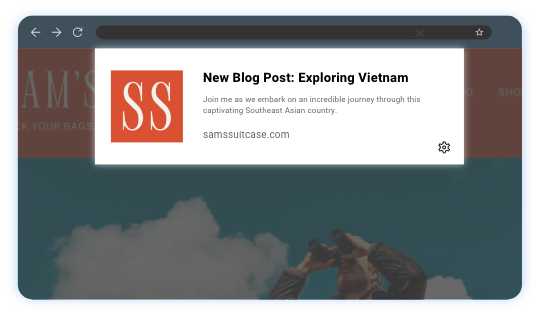
Let your audience know you have a new post directly in their desktop browser with web push notifications.
In just seconds, get ideas for your emails, a first draft, blog summary, and more.
Add your Canva creations directly into your email without ever leaving the email builder.
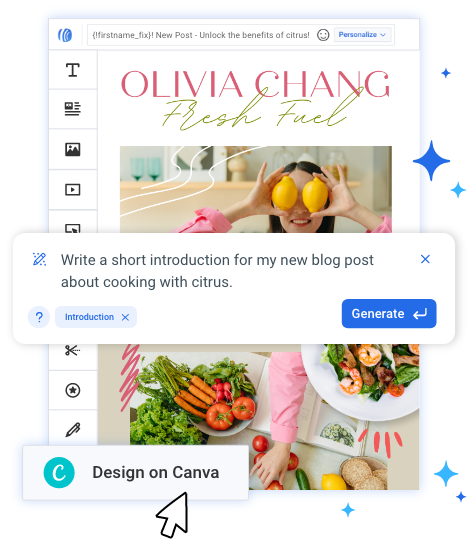
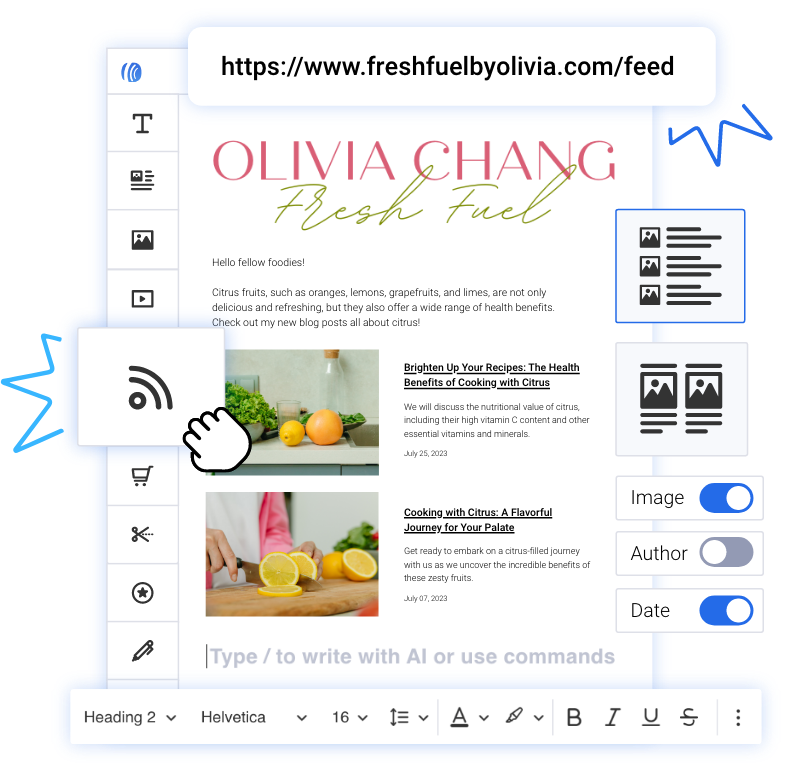
Automatically pull in your blog title, feature image, and description with link previews.
Customizable sign-up pages and forms that make it easy to capture new customers.

Kristie Gonzales | Stamp with Kristie
Easily capture leads and build your email list directly from your WordPress site.

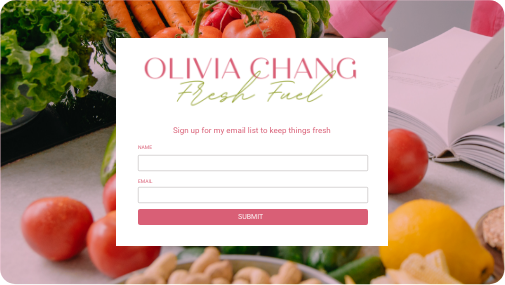
Making it easy to capture new subscribers with sign-up pages and forms.

Connect your domain, enabling seamless email authentication.
Unparalleled deliverability? Yes, please →


We’ll transfer lists, automations, forms, templates, and more from your current provider
Ready to switch? We've got you →



Google reviews
We make it easy to connect your email automation with the tools you use to run your business, including Facebook, PayPal, WordPress, Shopify, Zapier, and hundreds more.
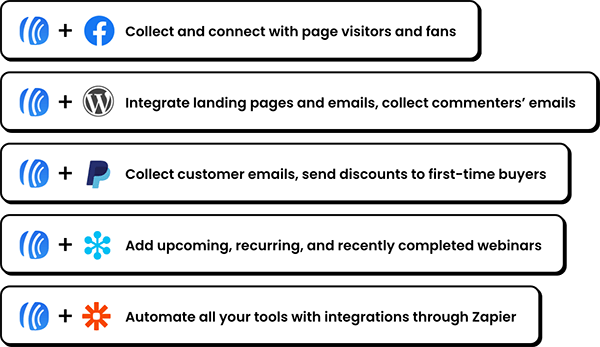

Support center